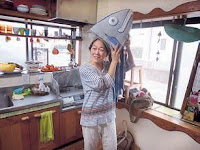 |
| The Yodo-line runs right next to the guesthouse |
Shimanto River, the last clear stream in Japan, only a minute away!
About 8 minutes walking distance from Tokawa Station on the Yodo Line, Shimanto-Cho’s first ever guesthouse preopened in July. The property, a former abandoned house which the owner rented out, is currently being renovated with major layout changes and new interior design. It is located next to the Yodo Line railroad, which is only a one minute walk from Shimanto River! Time seems to go by slower in this area, which is surrounded by mountains and the river. This time, a CIR and KIA staff member stayed at the guesthouse and gathered information.
About 8 minutes walking distance from Tokawa Station on the Yodo Line, Shimanto-Cho’s first ever guesthouse preopened in July. The property, a former abandoned house which the owner rented out, is currently being renovated with major layout changes and new interior design. It is located next to the Yodo Line railroad, which is only a one minute walk from Shimanto River! Time seems to go by slower in this area, which is surrounded by mountains and the river. This time, a CIR and KIA staff member stayed at the guesthouse and gathered information.
 |
| Sprawling mountains are only a short walk away |



















